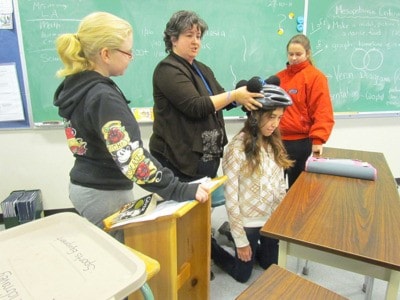What would it feel like to be one of the little people, or a dwarf as they are also called?
This was the question Lynn McGravey, who teaches at Barriere Elementary School, asked some intermediate classes when she recently gave a presentation about dwarfism.
Lynn’s three-year-old daughter, Reine, has a condition called achondroplasia (dwarfism), and the teacher explained to the students her family’s personal experience with this condition. She also explained that it was an opportunity to celebrate the 2011 Dwarfism Awareness Month.
Lynn said her daughter, Reine, had not accompanied her Mom today. “She would have kept the students busy watching her, because she is a lively active three-year-old who eagerly explores her surrounding wherever she goes,” said Lynn.
Instead she had chosen an interactive approach to give the students a sense of what it would be like to be a little person like Reine.
To begin with Lynn gave the students a short overview about the condition of dwarfism.
“The condition is not very common; only one or two babies are born in B.C. annually. The problem is that the body can not convert cartilage to bone, particularly the long bones in the arms and legs. As a result this creates the particular body structure of a large head, short arms and legs, small chest, trident fingers, depressed nasal bridge and limited range of mobility in elbow joints.
A dwarf child experiences many medical problems that require medical treatments and often difficult surgeries. Reine has undergone several treatments and surgeries that have required many trips to Children’s Hospital in Vancouver.
Now her parents and her brother, Ryder, share their lives with a happy energetic curly headed little girl who is full of smiles while she works her way around and over the obstacles in front of her.
With help from student volunteers, Lynn demonstrated, the kind of daily challenges Reine faces. Among several demonstrations was one with bocce balls placed on a helmet so students could observe first hand what balance challenges a small person with a large heavy head faces.
Stairs are another big obstacle for a little person, and Lynn explained the problems for this child filled with determination. She told the class that Reine tries to get to wherever she wants to go, but is not always successful, but she is determined.
This reporter had previously visited with Reine, and when the child wanted to negotiate going down a short staircase, she simply sat down and moved her bottom and legs from step to step as confidently as any three-year-old with an ordinary body structure would have done by walking down the stairs.
The teacher’s ‘life’ demonstrations, followed by a question and answer period, gave the students an understanding and knowledge about dwarfism and the physical problems that little people have to deal with every day.
“The biggest obstacle Reine, and others with an obvious disability will face, is other people’s perceptions of what she can and cannot do,” said the teacher, “If you have questions, ask them. For instance, what is the best terminology acceptable when talking to and about little people; little person, LP, dwarf, and short statured is alright, but midget is really offensive, and so are slight remarks about their appearance.”
In closing Lynn told the students what it meant to herself and her husband when their daughter came into their lives.
“When asked if I would change her? No!,” said the mom, “It took her Dad a little while to accept her condition; he was concerned about her quality of life and how she would be treated by others. I was relieved because originally we were given the impression that she might die. I waffle on whether I’d change her medical issues; she’ll learn things like compassion and to be more mature as a result, but it can be scary for the family. I don’t think it was an accident that Reine became part of our family given that her Dad’s brother was born with heart problems, and so we’re used to the hospital scene; and I am in a position to reach many people with education. God has a sense of humor in that my husband always used to think people were looking at him and now they definitely will be looking at our family given Reine’s condition. She has allowed us to really ‘see’ other people and accept them as they are.”
